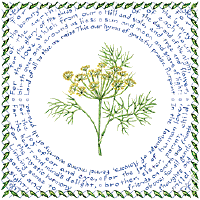LITERARY
CALLIGRAPHY
LINKS

 |
FENNEL The following excerpts from "Flowers, the Angels' Alphabet" by Susan Loy are © 2001 by CSL Press and Susan Loy. All rights reserved. |
FENNEL
"For the beauty of the earth, for the glory of the skies,
The words to the hymn, "For the Beauty of the Earth," were written by
Folliott Sanford Pierpont, an American who lived from 1835 to 1917.
Botanical Species: Foeniculum vulgare
Linnaeus first named fennel Anethum foeniculum, embracing two varieties - sweet fennel and common or wild fennel. Later botanists placed it with
Foeniculum, which means "little hay," the name given to this plant by the
Romans because of its hay-like odor, dividing it into two varieties, F.
vulgare, common or wild fennel, and F. dulce, sweet fennel.
Fennel was cultivated by the ancient Romans for its edible leaves,
seeds, and stalks, which taste like licorice. Pliny may have started the
superstition that fennel strengthens the eyes. It was included in
ancient victory wreaths as a symbol of strength and that which is worthy
of praise.
Description & Habitat: A tall herb, with delicate, feathery leaves that
grow from the edible root stalk. The small, yellow flowers, produced in
terminal clusters on up to twenty rays, resemble the flowers of the dill
plant. Considered indigenous to the Mediterranean region, it has spread
with civilization and may be found growing wild in many parts of the
world. It flourishes particularly on limestone soils near the sea.
© 2001 by CSL Press and Susan Loy. All rights reserved. Return to: LISTING OF SAMPLE CHAPTERS
Sentiment: Worthy of Praise
For the love which from our birth over and around us lies:
For the beauty of each hour of the day and of the night,
Hill and vale, and tree and flower, sun and moon and stars of light:
For the joy of ear and eye, for the heart and mind's delight,
For the mystic harmony linking sense to sound and sight:
For the joy of human love, brother, sister, parent, child,
Friends on earth and friends above; for all gentle thoughts and mild:
Lord of all to thee we raise this our hymn of grateful praise."
Common Name: fennel, wild fennel
| Purchase "Flowers, the Angels' Alphabet"... |  |
Order the Fennel Print from the LiteraryCalligraphy.com website.
Our Privacy Policy guarantees a safe and secure transaction!
[BOOK CHAPTER EXCERPTS] [BOOK REVIEWS] [PRESS ROOM RESOURCES]
[LISTING OF EXCERPTS] [CSLPRESS HOME PAGE]